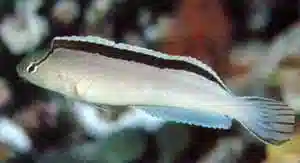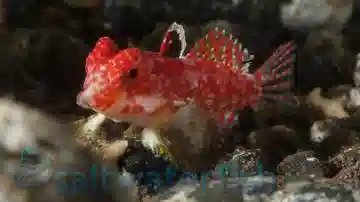Smith's Blenny
Meiacanthus smithii
(1 Reviews)

Smith's Blenny
Meiacanthus smithii
(1 Reviews)
{{ item.name }}
Size: {{ item.extra_field_3 }}
${{ getFormattedPrice(item.saleprice) }} ${{ getFormattedPrice(item.price) }}
To join the waiting list, click here
Free Shipping
With
$199.00
or more in Marine Life.
More details...
Smith's Blenny Care Facts
| Care Level: | Moderate |
|---|---|
| Temperament: | Peaceful |
| Diet: | Omnivore |
| Reef Safe: | Yes |
| Minimum Tank Size: | 30 gallons |
| Max Size: | 3 inches |
Smith's Blenny (Meiacanthus smithii): A Fascinating Addition to Your Saltwater Aquarium
Welcome to a comprehensive guide on the Smith's Blenny, scientifically known as Meiacanthus smithii. This educational product description explores this captivating species, providing essential information for saltwater marine aquarium enthusiasts. Topics covered include their natural habitat, reef compatibility, size, lifespan, dietary needs in captivity, compatibility with other marine species, sexual dimorphism, coloration changes from juvenile to adult stages, temperament, detailed tank requirements, and specific water conditions. Additionally, we list common names for this species and suggest five compatible tankmates while explaining why acquiring the Smith's Blenny from Saltwaterfish.com is a wise choice for your marine setup.
Habitat and Natural Range of Smith's Blenny
Welcome to a comprehensive guide on the Smith's Blenny, scientifically known as Meiacanthus smithii. This educational product description explores this captivating species, providing essential information for saltwater marine aquarium enthusiasts. Topics covered include their natural habitat, reef compatibility, size, lifespan, dietary needs in captivity, compatibility with other marine species, sexual dimorphism, coloration changes from juvenile to adult stages, temperament, detailed tank requirements, and specific water conditions. Additionally, we list common names for this species and suggest five compatible tankmates while explaining why acquiring the Smith's Blenny from Saltwaterfish.com is a wise choice for your marine setup.
Habitat and Natural Range of Smith's Blenny
Smith's Blennies, Meiacanthus smithii, are indigenous to the Indo-Pacific region, particularly the waters around Indonesia and the Philippines. They inhabit coral reefs and lagoon areas, often seeking refuge within crevices and coral branches. Vibrant coral colonies and diverse marine life characterize their natural environment.
Is the Smith's Blenny Known For Reef Compatibility
Smith's Blennies are considered reef-safe, making them an excellent choice for reef aquariums. Their small size and discreet nature contribute to their compatibility with corals and other reef-dwelling invertebrates. These blennies rarely pose a threat to corals or engage in aggressive behavior.
Size and Lifespan of the Smith's Blenny
Smith's Blennies are relatively small, typically reaching a maximum size of 2.5 inches (6 cm) in captivity. They can live for approximately 2 to 4 years with proper care and a suitable environment, providing a lasting presence in your marine aquarium.
What Should Smith's Blenny Eat in Captivity?
In captivity, Smith's Blennies exhibit unique dietary behaviors. They are omnivorous and have an interesting feeding strategy, which includes grazing on algae and hunting tiny zooplankton. To ensure their health and well-being, provide a well-balanced diet consisting of marine-based flake foods, pellets, frozen foods, and live offerings such as copepods and amphipods. Maintaining a varied diet is essential to replicate their natural feeding habits.
Compatibility of Smith's Blenny with Other Fish and Invertebrates
Smith's Blennies are known for their peaceful temperament, making them an ideal addition to community aquariums. Here are five compatible tankmates:
- Ocellaris Clownfish (Amphiprion ocellaris): These clownfish are vibrant and exhibit fascinating behaviors.
- Firefish (Nemateleotris spp.): Firefish share a peaceful disposition and add diversity to your aquarium.
- Royal Gramma (Gramma loreto): Known for their striking purple and yellow coloration, Royal Grammas are visually captivating.
- Cleaner Shrimp (Lysmata spp.): Cleaner shrimp are both functional and visually appealing.
- Gobies (Gobiidae family): Many goby species are compatible due to their small size and peaceful nature.
Sexual Dimorphism of Smith's Blenny
Smith's Blennies exhibit minimal sexual dimorphism, making it challenging to distinguish between males and females visually. In the aquarium trade, both sexes are typically represented simply as "Smith's Blenny."
Juvenile to Adult Coloration Changes
A dark body coloration with distinctive, horizontal yellow lines typically characterizes juvenile Smith's Blennies. As they mature into adulthood, their coloration, with vivid yellow accents and unique patterns, may become more pronounced.
Temperament of the Smith's Blenny
Smith's Blennies are known for their peaceful and non-aggressive temperament. They are often observed perching on rocks or corals, and their curious behavior adds charm to your aquarium.
Tank Requirements for the Smith's Blenny
Creating an ideal environment is crucial for the well-being of your Smith's Blenny. Here are essential tank requirements to consider:
- Minimum Aquarium Size: A tank with at least 30 gallons capacity is recommended for a single Smith's Blenny. Larger tanks can accommodate multiple specimens or other compatible species.
The Perfect Water Conditions for Smith's Blenny
Maintaining precise water conditions is crucial for the health and well-being of your Smith's Blenny:
- pH: Maintain a stable pH between 8.1 and 8.4 to support metabolic functions and overall well-being.
- Salinity: Ensure a stable salinity level within the range of 1.020 to 1.025, replicating the conditions of their native habitat.
- Water Temperature: Maintain a consistent water temperature between 75°F and 80°F (24°C to 27°C) to promote comfort and reduce stress.
- Water Flow: Provide gentle to moderate water flow to mimic their natural environment and support water quality.
Other Common Names for the Smith's Blenny
Apart from being known as Smith's Blenny, Meiacanthus smithi may also be referred to by common names such as:
- Blackline Fang Blenny
- Disco Blenny
Why People Should Buy the Smith's Blenny from Saltwaterfish.com
By choosing Saltwaterfish.com as your source for the Smith's Blenny, you gain access to a reputable provider dedicated to the well-being and health of marine species. Our specimens undergo rigorous sourcing, quarantine, and acclimation processes to ensure they are ready for aquarium life. Acquiring the Smith's Blenny from Saltwaterfish.com guarantees to introduce a healthy and adaptable specimen into your aquarium, enriching the diversity and dynamics of your marine environment. This captivating fish, with its intriguing behaviors and vibrant coloration, enhances the beauty of your saltwater aquarium, making it an engaging and visually appealing addition.
In conclusion, the Smith's Blenny, with its peaceful temperament and stunning appearance, is a valuable asset to saltwater aquariums. You can enjoy the benefits of a captivating and serene underwater world by meeting their specific care requirements and selecting compatible tank mates. Opt for the Smith's Blenny from Saltwaterfish.com to ensure the acquisition of a healthy specimen that will thrive and charm your aquarium for years.
I bought this Smith's Blenny here and to show you how hardy this guy is, he was the most active of 5 fish I had delivered when outside temp in MN was 21 degree out and bag water was at 68 degrees. All survived after 2 1/2 hr slow drip acclimation. He is a colorful little guy to watch darting around the tank. He is constantly on the move searching for food or detritus on the bottom as well as on reef rock. Likes to dart in and out of rock. He is getting much better at snagging Mysis shrimp I drop in before the other 6 fish hog it all, especially my Hamlet Indigo who gobbles everything that moves. A joy to watch.
Reviewed by: Philip Brock on Sept. 11, 2021















